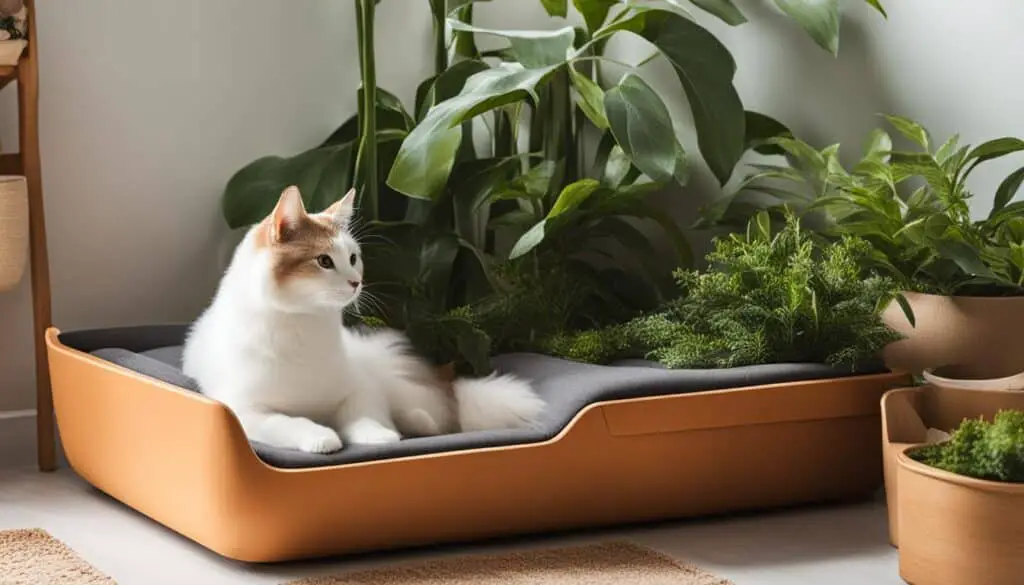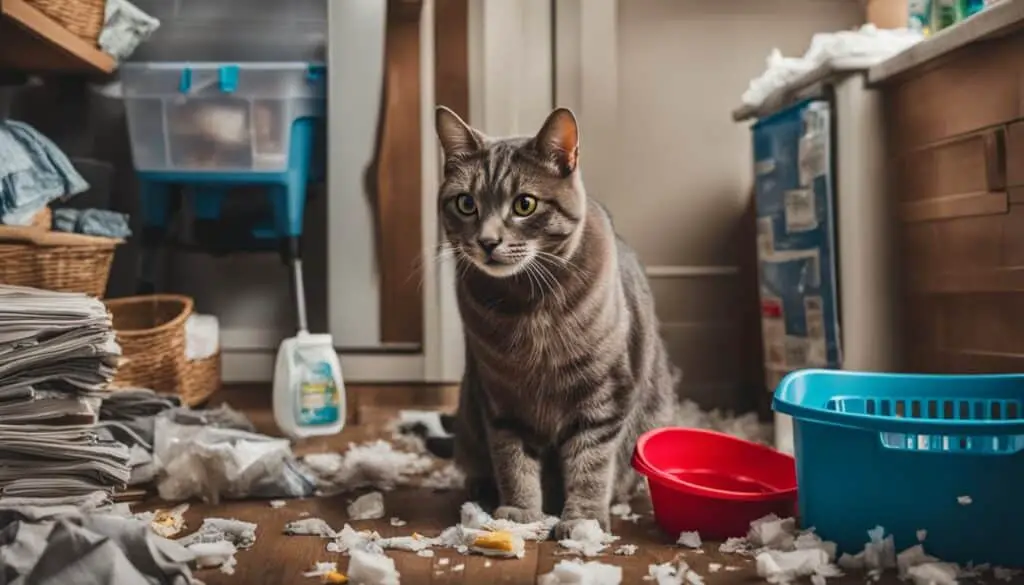As a cat owner, I understand the frustration that can arise when our feline friends develop litter box problems. These issues, ranging from accidents outside the box to refusal to use it altogether, can be both perplexing and problematic.
Fortunately, there are practical solutions to reducing litter box problems in cats. By addressing the underlying causes and implementing appropriate strategies, we can help our cats regain their litter box confidence and eliminate these stressful issues from our lives.
Key Takeaways:
- At least 10% of cats develop elimination problems, making it important to address these issues promptly.
- Common causes of litter box problems include conflicts between multiple cats, litter box management issues, and cat preferences.
- Inappropriate elimination can also be a result of underlying medical conditions, so ruling these out is crucial.
- Creating a cat-friendly litter box environment includes proper hygiene, litter type choices, and location considerations.
- Resolving litter box problems may require consulting a cat behaviorist or exploring behavior-modifying medication.
Why Do Some Cats Eliminate Outside the Litter Box?
Cats may eliminate outside the litter box due to various reasons. It’s important to identify these factors to address the issue effectively. Some common causes of litter box problems in cats include:
- Inadequate cleaning of the litter box
- Insufficient number or size of litter boxes
- Preferences or aversions to certain litter types or surfaces
- Location preference or aversion
- Physical limitations or negative associations with the litter box
Understanding these factors can help cat owners take appropriate measures to resolve the problem and promote proper litter box use.
Let’s take a closer look at each of these common causes:
“Inadequate cleaning of the litter box”
Cats are naturally clean animals, and they are more likely to avoid a dirty litter box. If the litter box isn’t cleaned regularly, it can become unappealing to the cat, leading to elimination outside the box.
“Insufficient number or size of litter boxes”
Cats prefer to have options when it comes to elimination. Having an insufficient number of litter boxes or using litter boxes that are too small can make cats reluctant to use them.
“Preferences or aversions to certain litter types or surfaces”
Just like humans, cats have their own preferences and aversions. Some cats may not like the texture or smell of certain litters, causing them to eliminate elsewhere. Experimenting with different litter options can help find one that the cat prefers.
“Location preference or aversion”
The location of the litter box can greatly influence a cat’s willingness to use it. Some cats may prefer a private, quiet location, while others may have aversions to specific areas.
“Physical limitations or negative associations with the litter box”
Physical limitations, such as arthritis or mobility issues, can make it difficult for cats to access the litter box. Additionally, negative experiences or associations, such as a fright or painful incident, can lead to aversions and avoidance of the litter box.
Addressing these common causes of litter box issues can help cat owners create a more suitable environment and promote proper litter box use. By understanding and addressing the underlying reasons, cat owners can work towards resolving the problem and preventing future incidents of elimination outside the litter box.
Medical Problems That Can Cause Inappropriate Elimination
Inappropriate elimination in cats can often be linked to underlying medical conditions. Cats may exhibit litter box problems due to medical issues such as urinary tract infections (UTIs), feline interstitial cystitis, kidney stones, or blockages. These conditions can cause pain, discomfort, or difficulty urinating, leading to the cat avoiding the litter box altogether. Therefore, it is important to consider the possibility of medical conditions when addressing a cat’s inappropriate elimination problem.
Urinary tract infections (UTIs) are a common medical condition that can affect a cat’s litter box use. Cats with UTIs may frequently enter the litter box but experience pain or have difficulty urinating. This discomfort leads them to associate the litter box with pain and avoid using it altogether. Similarly, feline interstitial cystitis can cause inflammation in the bladder, resulting in frequent trips to the litter box and discomfort during elimination.
Kidney stones or blockages can also lead to inappropriate elimination. These conditions can cause pain and discomfort during urination, making cats reluctant to use the litter box. The discomfort associated with elimination in these cases prompts cats to seek alternative places to relieve themselves, exacerbating the litter box problem.
Ruling out these medical issues is crucial in addressing a cat’s litter box problems effectively. A thorough veterinary examination is necessary to diagnose and treat any underlying medical conditions that may be contributing to the inappropriate elimination. By addressing these medical problems, cat owners can significantly improve their cat’s litter box use and overall well-being.
Basic Tips for Making Cats Feel Better About Using Their Litter Boxes
Creating a cat-friendly environment is crucial to promote proper litter box use. Here are some basic tips to help your cat feel more comfortable and confident when using their litter box.
1. Regularly Clean the Litter Box
Keeping the litter box clean is essential for maintaining good litter box hygiene. Scoop the litter box at least once a day and replace the litter regularly to prevent odor buildup and maintain a clean and inviting space for your cat.
2. Provide Enough Litter Boxes
Having enough litter boxes is important, especially in multi-cat households. The general rule is to have one litter box per cat plus an extra one. This ensures that each cat has easy access to a clean litter box without feeling crowded or overwhelmed.
3. Choose the Right Size and Type of Litter Box
Make sure the litter box is big enough for your cat to comfortably move around and easily assume their preferred elimination position. Avoid using litter boxes with hoods or liners as these can make cats feel confined and uncomfortable.
4. Select the Proper Type of Litter
When choosing litter, opt for a clumping, unscented variety. Most cats prefer the texture and feel of clumping litter, and unscented options minimize any potential aversions to strong odors. Consider using the same type of litter that your cat was exposed to during their kittenhood to create a sense of familiarity.
5. Consider the Location and Visibility
Place the litter box in a quiet and easily accessible area of your home. Cats prefer privacy when using the litter box, so avoid high-traffic areas and ensure that the box is not in close proximity to their food and water bowls.

By following these basic tips, you can create a cat-friendly litter box environment that meets your cat’s needs and preferences. This promotes good litter box habits and helps prevent any potential litter box issues.
Resolving a Litter-Box Problem
Resolving a litter box problem requires a systematic approach. As I mentioned earlier, it’s crucial to rule out any underlying medical causes that may be contributing to your cat’s elimination issues. Once you’ve confirmed that your cat is healthy, you can focus on addressing the behavioral and environmental factors that could be causing the problem.
One of the first steps in resolving litter box issues is to ensure that you have enough litter boxes available for your cat. As a general rule, you should have at least one litter box per cat, plus an additional box. This will help prevent any conflicts between cats and give each cat a dedicated space to use.
Placement of the litter boxes is also important. Make sure to place them in accessible locations away from high-traffic areas and any potential stressors, such as noisy appliances or the litter box being near the cat’s food and water bowls. Cats prefer privacy when using the litter box, so consider placing them in quiet corners or dedicated rooms where your cat feels comfortable.
Experimenting with different litter types can also make a difference. Some cats have preferences for certain textures, while others may avoid certain types of litter. By offering a variety of options, you can find the one that your cat prefers and increase the likelihood of successful litter box use.
Maintaining proper litter box hygiene is crucial. Regularly scooping and cleaning the litter box helps ensure that it remains inviting for your cat. Cats are clean animals, and they may avoid using a dirty litter box. Aim to scoop the box at least once a day and completely change the litter every week or two.
If you’ve tried all of these suggestions and your cat still has not resolved their litter box issues, it may be necessary to seek the help of a cat behaviorist. These professionals specialize in understanding cat behavior and can provide tailored advice to address your cat’s specific issues. In some cases, behavior-modifying medication may be recommended as a last resort to help your cat overcome their litter box problems.
Remember, resolving a litter box problem takes time and patience. By taking a systematic approach and addressing the various factors contributing to the issue, you can help your cat feel more comfortable and confident in using their litter box.

| Steps to Resolve Litter Box Problems: |
|---|
| 1. Rule out any medical causes for the issue. |
| 2. Ensure you have enough litter boxes available. |
| 3. Place litter boxes in accessible and private locations. |
| 4. Experiment with different litter types to find the cat’s preference. |
| 5. Maintain proper litter box hygiene by scooping and cleaning regularly. |
| 6. Consult a cat behaviorist for personalized advice. |
| 7. Consider behavior-modifying medication as a last resort. |
14 Litter Box Problem Solutions
When faced with litter box problems, there are several solutions to consider. By implementing these practical tips, you can address elimination issues and find a solution that works for both you and your cat.
-
Create a calm environment: Establish a routine for feeding and playtime to reduce stress. Use pheromone sprays or special treats to create a calming atmosphere for your cat.
-
Maintain litter box hygiene: Regularly clean the litter box to ensure it is fresh and inviting for your cat. Scoop waste daily and replace the litter as needed.
-
Provide shallow and appropriately sized boxes: Cats prefer a shallow depth of litter, around 1.5 to 2 inches. Ensure the litter box is large enough for your cat to comfortably turn around and dig.
-
Offer privacy: Place the litter box in a quiet and secluded area, away from high-traffic zones and noisy appliances. Consider using a covered litter box or adding a privacy screen.
-
Experiment with litter depth and type: Try different litter depths to see what your cat prefers. Cats have individual preferences for litter texture, so experiment with various types such as clumping, unscented, or natural options.
-
Avoid stressors: Keep the litter box away from stress-inducing factors, such as barking dogs or loud children. Creating a peaceful environment can help your cat feel more comfortable during elimination.
-
Provide multiple litter boxes: If you have multiple cats, ensure each cat has access to their own litter box. The general rule is to have one litter box per cat, plus an extra one.
-
Consider litter box location: Place the litter boxes in different areas of your home to accommodate your cat’s preferences. Some cats prefer private spaces, while others prefer more open locations.
-
Avoid negative associations: If your cat had a negative experience in the litter box, such as a painful urination due to a medical condition, they may develop aversions. Address any underlying medical issues and reintroduce positive experiences in the litter box.
-
Minimize changes: Cats are creatures of habit, so avoid frequent changes to the litter box setup. Stick to a consistent routine and maintain a stable environment to alleviate stress.
-
Eliminate odors: Cats are sensitive to strong smells, so use unscented litter and avoid cleaning products with strong fragrances near the litter box area.
-
Monitor your cat’s health: Regular veterinary check-ups can help detect and address any underlying medical conditions that may contribute to litter box problems.
-
Consult a cat behaviorist: If you’ve tried various solutions and your cat continues to have litter box issues, seek professional guidance from a cat behaviorist. They can provide personalized advice and strategies to resolve the problem.
-
Consider behavior-modifying medication: In severe cases, medication prescribed by a veterinarian may help modify your cat’s behavior and address elimination issues.
Pros and Cons of Common Litter Box Solutions
| Solution | Pros | Cons |
|---|---|---|
| Using covered litter boxes | – Provides privacy for the cat – Controls litter scatter |
– May trap odors – Some cats may feel trapped or intimidated |
| Offering various litter types | – Allows you to find the litter type preferred by your cat – Helps address texture aversions |
– Requires experimentation – Some litter types can be messy or tracking |
| Maintaining regular litter box cleaning | – Ensures a clean and inviting environment – Helps prevent odor buildup |
– Requires daily maintenance – Some cats may be sensitive to cleaning products |
| Placing litter boxes in different locations | – Accommodates individual cat preferences – Provides options for multi-story homes |
– May require more space – Difficult to monitor litter box use for all cats |
Quote:
“Addressing litter box problems requires a combination of practical solutions and understanding your cat’s unique preferences. By creating a cat-friendly environment, maintaining cleanliness, and considering individual needs, you can effectively resolve elimination issues.” – Cat Behaviorist Emily Collins
Is Your Cat Still Not Using the Litter Box?
If your cat continues to have persistent litter box issues despite implementing various solutions, it may be beneficial to consult a cat behaviorist. These professionals specialize in understanding feline behavior and can provide customized advice to address your cat’s specific needs. Consulting a cat behaviorist can help identify the underlying causes of your cat’s aversion to using the litter box and provide effective strategies for resolving the issue.
In some cases, behavior-modifying medication may be prescribed to complement behavior modification techniques. Medication can be helpful when there are underlying anxiety or stress-related issues contributing to your cat’s litter box problems. However, this should always be discussed with a veterinarian or a feline behaviorist who can carefully evaluate your cat’s situation and determine the appropriate course of action.
Consulting a Cat Behaviorist
When seeking the guidance of a cat behaviorist, it’s important to choose a reputable professional with experience in feline behavior. Look for a cat behaviorist who is certified by recognized organizations, such as the International Association of Animal Behavior Consultants (IAABC) or the Animal Behavior Society (ABS).
During the consultation, the cat behaviorist will likely observe your cat’s behavior, ask you detailed questions about the litter box problems, and assess your home environment. Based on their evaluation, they will provide targeted advice tailored to your cat’s specific needs. This may include recommendations for modifying the litter box setup, changes to the home environment, behavior modification techniques, and other strategies to encourage appropriate litter box use.
Keep in mind that results may not be immediate, and it may take time and patience to see improvements. Consistency and following the behaviorist’s recommendations are key to success.
Considering Medication
Behavior-modifying medication can sometimes be a helpful tool in addressing persistent litter box issues. It is typically used as part of a comprehensive treatment plan and should always be prescribed and monitored by a veterinarian.
Medication can help reduce anxiety, stress, and other underlying behavioral issues that may be contributing to the cat’s aversion to the litter box. Some common medications prescribed for litter box problems include selective serotonin reuptake inhibitors (SSRIs), tricyclic antidepressants (TCAs), and benzodiazepines.
It’s important to note that medication should never be the first line of treatment and should only be considered after addressing other possible causes and implementing behavior modification techniques. Consulting with a veterinarian or a cat behaviorist is crucial for determining if medication is necessary and safe for your cat.
| Advantages of Consulting a Cat Behaviorist | Considerations for Medication |
|---|---|
|
|
If your cat is still not using the litter box despite your efforts, consulting a cat behaviorist and considering medication can be important steps in finding a solution. Remember to be patient and consistent in implementing their recommendations, and always prioritize your cat’s well-being and comfort.
Conclusion
In conclusion, solving litter box problems in cats requires a thorough understanding of the root causes and implementing appropriate solutions. By addressing environmental factors, maintaining litter box hygiene, and considering the cat’s preferences and medical conditions, cat owners can effectively reduce or eliminate litter box problems.
Addressing litter box issues involves creating a cat-friendly environment with clean and accessible litter boxes in suitable locations. Choosing the right type of litter and providing privacy are essential. It’s important to observe the cat’s behavior and consult a cat behaviorist if necessary for personalized advice and guidance.
Patience and consistency are crucial throughout the process. It may take time for cats to adjust to new litter box practices, and owners should avoid punitive measures that can worsen the problem. Seeking professional guidance when necessary and considering behavior-modifying medication as a last resort can help ensure a positive outcome for both the cat and the owner.
FAQ
How common are litter box problems in cats?
Approximately 10% of all cats develop elimination problems, so it’s quite common.
What are some common causes of cats eliminating outside the litter box?
Cats may eliminate outside the litter box due to issues like litter box management problems, litter type or surface preferences, and location preferences or aversions.
Can medical problems cause inappropriate elimination in cats?
Yes, underlying medical conditions such as urinary tract infections or feline interstitial cystitis can lead to inappropriate elimination in cats.
How can I make my cat more comfortable using their litter box?
To make your cat more comfortable using their litter box, ensure it is clean, the right size, and without a hood or liner. Use the litter type your cat prefers and place the litter box in a suitable location.
How can I resolve a litter box problem in my cat?
Resolving a litter box problem requires ruling out medical causes, providing enough litter boxes, placing them in accessible locations, and experimenting with litter types and hygiene.
What are some practical solutions for addressing litter box problems?
Practical solutions include establishing a routine, reducing stress, keeping the litter box clean, providing appropriately sized boxes, and offering privacy to your cat.
What should I do if my cat is still not using the litter box?
If your cat continues to have litter box problems despite trying various solutions, it may be helpful to consult a cat behaviorist or consider behavior-modifying medication.





No Comments